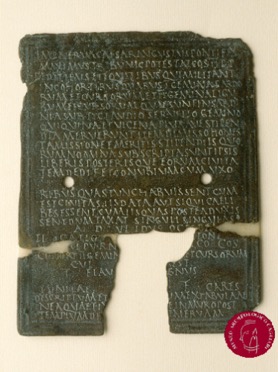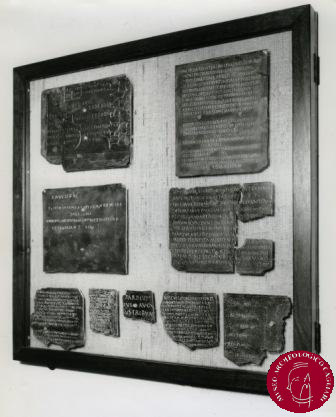Bronze military Diploma (Su Anzu)
The military diploma is a document consisting of a pair of small bronze rectangular boards (from about 10x12cm to 14x21cm, which vary according to the period of production), bound to each other along the long side by means of wires also in bronze and written on both sides.
They always carried specially protected official seals. It documents, following the honesta missio, the granting of the civitas (Roman citizenship) and the recognition of ius connubii (i.e. the legalisation of a marriage possibly contracted whilst peregrinus or the right in any case to marry legitimately), that is the possession of all civic rights, for his children and for his descendants.
Every soldier involved was given a copy at the time of his discharge, while the original was displayed in Rome on a wall located behind the Temple of the Divine Augustus, near the temple of Minerva, although none of these has ever been found, perhaps because they were melted in later times after the fall of the Western Roman Empire. Examples are known from the Age of Claudius (41-54 A.D.) up until the beginning of the fourth century A.D. Of the ten military diplomas found in Sardinia to date, three military diplomas have actually been found in the hinterland of Ogliastra, the heart of Barbaria, which prove the return of Sardinian peregrini to the island after years of service completed in the operational headquarters of the fleets of Miseno and Ravenna. A bronze military diploma consisting of three fragments was found in 1830 at the baths of San Giovanni Su Anzu (figs. 1, 2).
During the same year, the artefact came into the possession of the high chaplain of the church of S. Efisio in Cagliari, who donated it to the Archaeological Museum of Cagliari (fig. 3). This is the discharge document issued on 10th October, 96 A.D. by the Roman Emperor Nerva (96-98 A.D.) in favour of the Roman soldier Tunila, from the II Cohort Gemina of Liguria and Corsica soldiers operating in Sardinia, for having served in the military for more than twenty-five years. The holes which can be seen on the surface allowed the passage of wires fastened by seals which held together the two original foils. The ethnicity of Tunila, Cares(ius), would suggest that he probably originated from a town located near the river Cedrino.



Bibliografia
- BONINU A., Testimonianze di età romana nel territorio di Dorgali, in Dorgali. Documenti archeologici, Sassari 1980, pp. 221-240.
- M.R.MANUNZA, Dorgali. Monumenti antichi, Oristano, 1995, p. 201.
- MASTINO A., RUGGERI P., La Romanizzazione dell'Ogliastra, in Ogliastra. Identità storica di una Provincia. Atti del Convegno di Studi (Jerzu-Lanusei-Arzana-Tortolì, 23-25 gennaio 1997), Comunità Montana n. 11-Ogliastra, 2000, pp. 155-158.
- PULACCHINI D., Il museo archeologico di Dorgali, Sardegna Archeologica. Guide e itinerari, 27, Sassari 1998, p. 40.
- TARAMELLI A., Edizione archeologica della Carta d’Italia, Foglio 208 (Dorgali), Firenze 1929, p. 20, n. 5.

 VR
VR